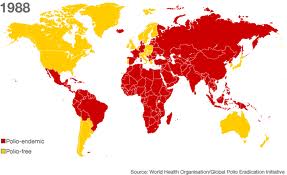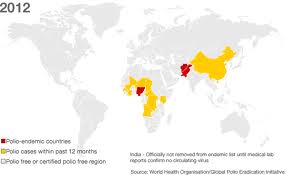The following article provided discusses Rotary’s END POLIO NOW programme
Since Rotary joined the worldwide fight to eliminate Polio by launching its “End Polio Now" campaign in 1985, it has raised over $1bn in donations and over 2.5bn children under the age of 5 have been immunised.
Polio has been around for many centuries, even going back to 1400BC. The disease was given its first clinical description in 1789 by the British physician Michael Underwood, and recognised as a condition by Jakob Heine in 1840. The first modern epidemics were fuelled by the growth of cities after the industrial revolution. It became a major public health issue in late Victorian times with major epidemics in Europe and the United States. In 1916, New York experienced the first large epidemic, with more than 9,000 cases and 2,343 deaths. The 1916 toll nationwide was 27,000 cases and 6,000 deaths. Children were particularly affected. Major outbreaks became more frequent during the century: in 1952, the US saw a record 57,628 cases. A major breakthrough came in 1952 when Dr Jonas Salk began to develop the first effective vaccine against polio. Mass public vaccination programmes followed and had an immediate effect; in the US alone cases fell from 35,000 in 1953 to 5,300 in 1957. In 1961, Albert Sabin pioneered the more easily administered oral polio vaccine (OPV). Despite the availability of vaccines, polio remained a threat, with 707 acute cases and 79 deaths in the UK as late as 1961. In 1962, Britain switched to Sabin's OPV vaccine, in line with most countries in the developed world. There have been no domestically acquired cases of the disease in the UK since 1982.
By 1988, polio had disappeared from the US, UK, Australia and much of Europe but remained prevalent in more than 125 countries. The same year, the World Health Assembly adopted a resolution to eradicate the disease completely.The WHO Americas region was certified polio free in 1994, with the last wild case recorded in the Western Pacific region (which includes China) in 1997. A further landmark came in 2002, when the WHO certified the European region polio-free.By 2012, Polio remained officially endemic in just four countries - Afghanistan, Nigeria, Pakistan and India.In fact, on 13th January this year, India celebrated three continuous years with no reported cases and the WHO removed India from the list of endemic countries – a particular feat given the large population and difficult terrain..
Despite so much progress, polio remains a risk with virus from Pakistan re-infecting China in 2011, which had been polio free for more than a decade.Today, just three countries remain on the endemic list; Nigeria, Pakistan and Afghanistan. In 2012, there were 175 new cases of polio reported; 97 were in Nigeria, where local religious leadersin the north suspected the West were attempting to sterilise the Muslim population with the vaccine. For a year the programme was suspended. The programme is now back on track and the number of cases falling.
But there are still some serious concerns; new outbreaks have been reported in or close to three conflict areas: Somalia where 183 new cases were reported mainly in the refugee camps and is thought to have originated in Nigeria; in Kenya, across the border from Somalia, 8 new cases have been reported; and in Syria where a state of Civil war exists with a growing refugee problem, 13 new cases have been reported which are thought to have originated in the tribal areas of Pakistan. Countries bordering northern Nigeria, particularly Chad have also reported new cases as the virus migrates across the border.
As a wild virus, the fear is that the virus could escape from its current containment areas and spread to areas that have not experienced a single case of Polio for decades; such as Europe, The Americas and yes, the BVI. With the ease of International travel, the opportunity for the virus to escape is huge. Which is why the fight against Polio must continue.
So What is Polio; well it’s a virus, which causes spinal and respiratory paralysis by entering the nervous system; victims can be paralysed and their limbs deformed; it can kill and remains incurable, but vaccines have assisted in its almost total eradication today.
How is it contracted? Polio is spread through person-to-person contact. When a child is infected with wild poliovirus, the virus enters the body through the mouth and multiplies in the intestine. It is then shed into the environment through the faeces where it can spread rapidly through a community, especially in situations of poor hygiene and sanitation. If a sufficient number of children are fully immunized against polio, the virus is unable to find susceptible children to infect, and dies out.
Young children who are not yet toilet-trained are a ready source of transmission, regardless of their environment. Polio can be spread when food or drink is contaminated by faeces. There is also evidence that flies can passively transfer poliovirus from faeces to food.
Most people infected with the poliovirus have no signs of illness and are never aware they have been infected. These symptomless people carry the virus in their intestines and can “silently” spread the infection to thousands of others before the first case of polio paralysis emerges. –
The State of Play – countries were Polio remained endemic


The fight against Polio is being led by the Rotary Foundation, The World Health Organisation and UNICEF, as well as many national Governments and agencies. Rotary has been extremely fortunate that Bill and Melinda Gates have actively supported Rotary’s fundraising activities through the Bill and Melinda Gates Foundation. The Foundation have so far donated $355m against Rotary raising $250m. This part of the programme ended last year with Rotary exceeding its pledge. Furthering their support, the Foundation have now pledged to triple each dollar that Rotary raises between now and 2018.
For as little as 0.60c, a child can be vaccinated against polio for life. We have come so far; can we afford to let up now?
So what can you do? Well you can donate. Go to http://www.endpolio.org/donate and make your donation. You can support the “Walk to End Polio” on Saturday 25th January starting at the Sunday morning Well at 5.30am. And you can vote – go tohttp://www.endpolio.org/about-polio . Influence your local leaders to help ensure that Polio is eradicated for ever throughout the world and by extension never reaches our community.
